
Climate ambition is nuanced and context specific. This new United Nations Development Programme (UNDP) report explores how the world is progressing on climate ambition – Who is leading the way? And who is falling behind? – through a unique perspective that assesses global intentions and also draws on data and evidence from more than 120 developing countries. Despite many challenges, it demonstrates that there are also reasons to be hopeful for the future.

We are living in unprecedented times
The world is navigating a triple planetary crisis of climate, nature loss, and pollution. Climate change is now widespread, rapid, and intensifying. From wildfires and floods to hurricanes and droughts – the impacts of climate change are affecting every region across the globe and being accelerated by unsustainable land use practices, eroding ecosystems, and warming oceans.
It won’t be easy, but scientists say that it is possible to prevent a climate catastrophe if immediate, rapid, and large-scale action to slash greenhouse gas (GHG) emissions is taken – but each degree matters, each year matters, and each decision matters.
The Paris Agreement’s “ratchet mechanism” is working, but the world needs greater ambition
At the heart of the Paris Agreement are Nationally Determined Contributions (or NDCs) in which nations describe their country-specific contributions to reducing GHG emissions. They also commit themselves to submit increasingly ambitious pledges every five years. This is known as the “ratchet mechanism” of the Agreement.
How global climate ambition has progressed from 2019 to 2021.
What is clear is that Least Developed Countries (LDCs) and Small Island Developing States – countries that are among the most vulnerable to the impacts of climate change and contribute to only 7% of global GHG emissions – are collectively leading the way on pledging to raise ambition. But the G20, responsible for more than three-quarters of global GHG emissions and 80% of global Gross Domestic Product, must show much greater leadership by acting urgently and boldly on climate action if the world is to achieve the Paris Agreement’s global goals.
Countries have worked hard to submit better-quality NDCs in a timely manner
Despite the COVID 19 pandemic, the number of “second-generation” NDCs submitted to the UN Framework Convention on Climate Change (UNFCCC) grew from two in September 2019 to 143 as of 12 October 2021. It is anticipated that 38 more countries will submit NDCs by the end of 2021, with the majority still aiming to do so by the COP26 negotiations in Glasgow in November. This would bring the total number of second-generation NDCs to 181 – a significant increase over global intentions in 2019.

Second-generation NDCs are higher quality, more inclusive, and country driven. However, finance remains a key hurdle, which impacts their implementation feasibility. Industries, sectors and investors need decisive policy signals and incentives to transition immediately from brown to green practices. All countries must be fully committed to prioritising the financing and implementation of enhanced NDCs.
Combatting the climate crisis will require a complete transformation of society
For many countries – but not all – inclusivity is driving ambition. UNDP’s own Climate Promise initiative has contributed to this effort, supporting governments to engage with 110,000+ people reached through 1,260 stakeholder consultations on NDC revision processes.
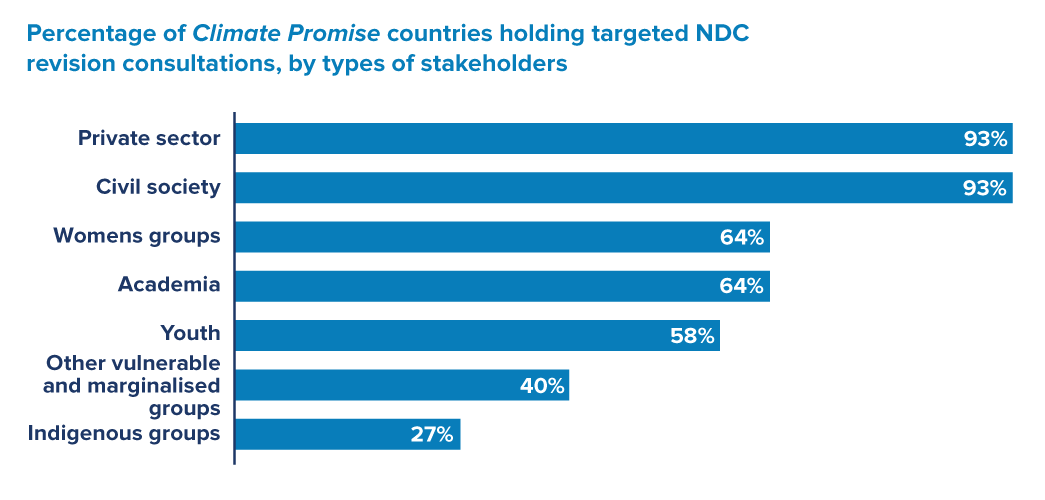
There must be greater recognition and empowerment of the roles of key change agents. Countries are increasingly engaging the private sector in NDC design and implementation, as they are critical to ensuring sufficient scaled up climate action, but not adequately defining their needs in just transition processes. Gender and youth considerations have also improved significantly in second-generation NDCs, but more needs to be done to capitalise on their potentials – particularly youth as the generation most invested in the call for higher climate ambition.
Let’s find more solutions
The NDC Global Outlook report demonstrates how many developing countries across the world are leading the way for decisive climate action. COP26 must be the moment where all nations rise to the challenge of climate change, especially high-emitters. As the window to limit global warming to 1.5°C narrows, this is our only pathway to secure the future of people and planet.
A “helicopter” view of the climate planning landscape from 2020 to 2050 reveals that the opportunity afforded by NDCs to serve as a blueprint for sustainable development and green recovery is only just beginning to be utilised.
For the most part, NDCs remain focused on sectoral priorities – rather than identifying integrated solutions that target broader systems. They have not been integrated into the green stimulus and recovery plans that countries are putting forth to rebuild their economies after the COVID-19 pandemic. This is a missed opportunity to realign investments from “brown” to “green” and to address the financial barriers hampering scaled-up climate action and ambition.
Zimbabwe
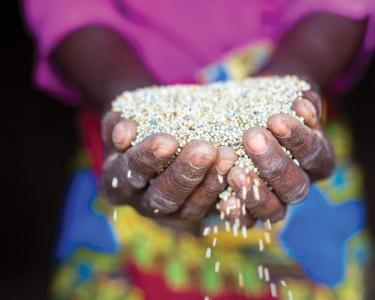
Measuring green job creation for a fairer, greener economy
Zimbabwe is among the world’s 50 most vulnerable countries to climate change (Zimbabwe revised NDC), so its revised NDC, and wider climate policy, focuses on adaptation as much as mitigation. Zimbabwe’s economy is highly reliant on agriculture and forestry, and the government has expressed its determination to ensure a “just transition to a climate-resilient, low-carbon economy”. The revised NDC combines Zimbabwe’s commitments to the Paris Agreement with its national Vision 2030, the aim of which is to turn Zimbabwe into an upper middle-income economy “with no-one left behind.” The government is anxious to ensure that the benefits of delivering a greener economy are widely shared, and support is provided to those that may be at risk from the move, for example those that currently work in polluting industries.
To measure the economic and social impact of the proposed new climate policies across the whole of society – including women and young people – Zimbabwe has been amongst the first countries in the world to conduct a green job assessment. The International Labour Organization (ILO) and UNDP carried out the research involving a wide range of stakeholders. Nathan Banda, Safety Health and Environmental Officer at the Zimbabwe Congress of Trade Unions, was involved in the process. He reports: “We are proud as a country for having come up with the NDC followed by the Low Emission Development Strategy. It has remained my hope that more jobs will be created as we migrate from brown to green economy.”
The assessment found that overall, Zimbabwe’s climate policies present huge potential for job creation as long as they are backed up by social policies which support appropriate labour-market and skills-enhancement. For example, investments in conservation agriculture could create up to 30,000 jobs for every million US dollar invested.
Such findings provide precious insights for policymakers to understand the impact of certain NDC-related policies and enable them to choose those which reduce greenhouse gas emissions whilst also bringing economic and social benefits that can be widely shared across all levels of society.
North Macedonia
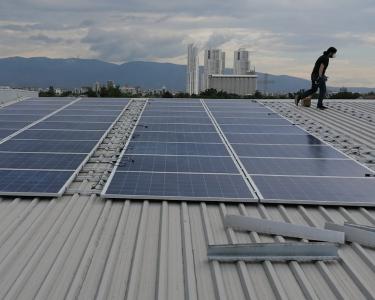
Private sector are the leaders in the green economy
In North Macedonia, the private sector leads the way in greening the economy. An outstanding example is Propoint, a printing company in Skopje. Despite initial scepticism from some investors, Propoint recently went ahead with introducing a new 100% green production model inspired from a similar Finnish company. In 2018, they switched to solar energy for their printing house by installing photovoltaic panels with a capacity of 425 KWh. They also began phasing out their old petrol -powered delivery vans and replacing them with electric vehicles.
The result: In the first year alone, the clean electricity produced 500 megawatts, with CO2 emissions reduced by an impressive 470 tons. The company does not even use all the electricity produced, so any surplus is placed on the distribution network. They are justifiably proud of their new lean, clean workplace and of their contribution to tackling global warming. They are enthusiastic about continuing. “We are gradually achieving our goal to become a ‘100% green company’,” says owner Filip Hristov.
Proprint’s success is an inspiring example of what can be achieved when the private business sector mobilises. North Macedonia’s second national pledge, released in April 2021, involved the private sector committing to deliver the majority (85%) of the total investment needed for implementing green policies in industry. Thanks to this bold move, the Republic of North Macedonia has been able to revise its targets from 36% to 82% reduction in net greenhouse gas emissions by 2030, compared to 1990.
Chile
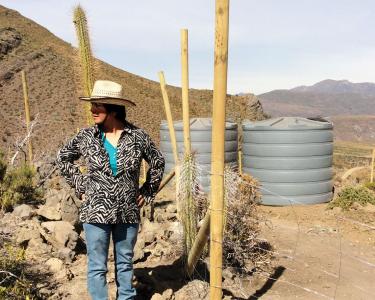
Chile’s local communities fight desertification in Combarbalá, Chile. © 2016 UNDP Chile.
Climate and green financing support the country’s commitment to carbon neutrality by 2050
Chile has a strong commitment to climate change mitigation and environmental protection. To reach its mitigation and adaptation goals, the country has identified a set of implementation measures that include capacity building, technology development and transfer as well as climate finance, an area in which the Ministry of Finance has already led several notable initiatives.
Chile is one of the founding members of the Coalition of Finance Ministers for Climate Action. It also issued in June 2019 the first sovereign green bonds in South America, a climate financing tool that focus investments on sustainable public projects like low carbon transportation or the construction of green public buildings. On the same year, it published, during COP25, its first financial strategy on climate change.
The strategy provides a framework to achieve the transition towards a low emission and climate resilient economy. It determines how to finance the required transformations in all sectors that play a crucial role towards these goals: NDC target to limit total annual emissions to 95 million tonnes of CO2 equivalent by 2030 and the national objective to reach carbon neutrality by 2050. This implies having reliable information, data and analysis to support better budgetary planning and decision-making on public investment priorities.
To that end, Chile has been developing a climate fiscal framework for measuring climate national public expenditure. Cristobal Gamboni, Macroeconomic and International Finance Coordinator at the Ministry of Finance, has worked, together with UNDP, on the climate public expenditure review, which is the first step of building a climate fiscal framework. “We have seen the need to have accurate and detailed information about climate-related expenditure as an input to make better decisions in a context of limited resources.”
Like its NDC, Chile’s financial strategy on climate change is due to be updated every five years.
Papua New Guinea

Mt Balbi conservation area, Bougainville. © Nick Turner/UNDP
Sustainable forest management is vital to curb emissions and build resilient communities
As forests cover 78% of the total land area across the country, John Moroso, Acting Manager Director of the Forest Authority in Papua New Guinea, is fighting hard the negative effects of climate change. “The conservation of forests is not only vital to the livelihoods of the rural population [which represents more than 75% of the total population], it is also a key component for achieving our country’s targets under the enhanced NDC,” he says.
Recognizing that the Land Use, Land-Use Change and Forestry (LULUCF) sector was one of the biggest contributors to greenhouse gas emissions in Papua New Guinea, the government has dramatically increased references to forests from 35 in the first NDC to 173 in the updated NDC submitted in December 2020.
An increase of deforestation and forest degradation in recent years is largely owing to land-use conversion from forest land to subsistence agriculture, oil palms plantation development, and commercial logging, as a result of the country’s rapid population growth and fast-growing economy.
Papua New Guinea has committed to reduce the annual emissions from deforestation and forest degradation by 10,000 Gg CO2eq by 2030, compared to 2015, which is equivalent to an annual reduction of 8,300 ha of deforestation and 43,300 ha of degradation. To attain this goal, John explains that “the Forest Authority addresses high rate of forest degradation through sound logging practices. This includes reducing the export of round logs by more than 50% percent in 2025 as well as promoting plantation development in the country”.
Papua New Guinea’s enhanced NDC sets concrete targets to reduce GHG emissions in both the forest and energy sectors. Their timely fulfilment will contribute to the country’s commitment to be 50% carbon neutral by 2030 and entirely carbon neutral by 2050.
Somalia
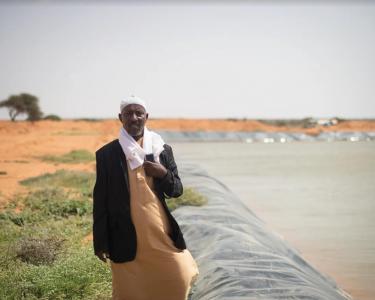
Fighting climate change is the key to ongoing peace and stability
While suffering prolonged periods of political upheavals and civil instability, Somalia is also particularly vulnerable to climate change impacts. Its GHG emissions are minor in comparison to many other countries, but Somalia suffers disproportionately from the climate crisis in the form of regular, and worsening, droughts and floods. Since 70% of its GDP is derived from livestock and agricultural activities, climate plays a key role in Somalia’s economy and is crucial for the livelihood of the population.
The government’s response to these challenges has been to develop an ambitious updated NDC as an integral part of the country’s plans for a more peaceful, stable and prosperous future. As Deputy Prime Minister Mahdi Mohammed stated recently, “conflict and extremism has, to a large extent, been fuelled by the climate crisis and natural resource degradation”, and consequently, “addressing climate change is an important step toward achieving peace and stability in Somalia”.
Adaptation to climate change and enhancement of resilience is a national imperative. Somalia’s second-generation NDC is supporting this challenge by proposing adaptation actions for key sectors such as agriculture and food security, water resources management, public health, and disaster preparedness, among others. The estimated cost of implementing these resilience and adaptation initiatives is $48.5 billion between 2021 and 2030.
A recent example is the construction of 10 dams in the Shakda district, which the local Commissioner, Abdishakur Ise, believes play an important role in maintaining peace in the area: “The most important thing for human beings is peace,” he says, “the second is water.” The dams, built by the government with support and funding from UNDP and the Global Environment Facility (GEF), allow local communities and their livestock to access clean water all year long and to manage water shortages during dry seasons and droughts. The same project is also helping camel herders to protect their land and livestock from soil erosion and flash floods. The construction of stone barricades over twenty sites now protects land for nearly 50,000 families.
To read more country stories, download the full report.